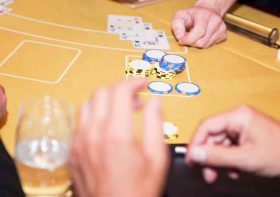The Mathematics of Blackjack: Odds and Probabilities

Blackjack is one of the most popular casino games worldwide, and if you want to increase your chances of winning, understanding the mathematics behind it is crucial. In this article, we will delve into the odds and probabilities involved in blackjack and how you can use them to your advantage.
The Basics of Blackjack
Before we dive into the mathematics, let’s briefly review the basics of blackjack. The objective of the game is to have a hand total closer to 21 than the dealer’s hand total, without exceeding 21. Each card has a value, with numbered cards worth their face value, face cards (King, Queen, Jack) worth 10, and the Ace worth either 1 or 11, depending on the player’s choice.
The game begins with the player receiving two cards and the dealer receiving one face-up card. Based on the player’s hand and the dealer’s visible card, the player must make a decision whether to Hit (draw another card), Stand (keep the current hand), Double Down (double the initial bet and receive one more card), or Split (in case of two identical cards, the player can split them into two separate hands).
The Importance of Odds and Probabilities
The mathematics of blackjack revolves around understanding the odds and probabilities associated with each possible outcome. This knowledge allows players to make informed decisions and strategically increase their chances of winning. Let’s examine some key concepts related to odds and probabilities in blackjack.
The Probability of Busting
One of the most critical probabilities to consider in blackjack is the chance of busting, meaning exceeding 21. This probability is influenced by the player’s current hand total and the dealer’s visible card. By analyzing the probabilities, players can better decide whether to hit or stand.
An Example
Suppose you have a hand total of 14, consisting of a 10 and a 4, and the dealer’s visible card is a 6. To calculate the probability of busting, you need to determine the number of cards that will cause you to exceed 21 divided by the number of remaining cards in the deck.
In this scenario, if you hit, there are 5 cards (any 2, 3, 4, 5, or Ace) that will cause you to bust. Since there are 52 cards in total and you know your two cards and the dealer’s visible card, there are still 49 unknown cards left. Thus, the probability of busting is 5/49 (approximately 10.2%). Based on this probability, you can make an informed decision on whether to hit or stand.
The Odds of Winning a Hand
Another essential aspect of blackjack mathematics is calculating the odds of winning a hand. This probability can vary depending on various factors, including the player’s hand total and the dealer’s visible card. Understanding the odds of winning allows players to evaluate the risk/reward ratio and adjust their betting strategy accordingly.
An Example
Let’s consider a situation where you have a hand total of 18 (consisting of a 10 and an 8), and the dealer’s visible card is a 7. To calculate the odds of winning, you need to assess the chances of obtaining a hand closer to 21 compared to the dealer without going over it.
Based on mathematical calculations and probabilities, you discover that drawing an Ace, 2, 3, 4, or 5 will improve your hand total without exceeding 21. There are five favorable cards for you. Additionally, you know that the deck contains 49 unknown cards after considering your two cards and the dealer’s visible card.
Therefore, the odds of drawing a favorable card from the remaining deck are 5/49 (approximately 10.2%). By comparing this probability to the odds of the dealer obtaining a hand better than yours without going over 21, you can make a strategical decision.
Strategies Based on Mathematical Calculations
Understanding the mathematical probabilities and odds of blackjack enables players to implement strategies that can enhance their chances of winning. Here are a few effective strategies derived from mathematics:
Basic Strategy
The basic strategy involves making decisions regarding hitting, standing, doubling down, or splitting based on mathematical calculations and probabilities. It provides players with the most optimal play in every possible scenario, reducing the house edge and maximizing the chances of winning.
Card Counting
Card counting is a more advanced strategy that involves keeping track of the cards that have been played to predict the likelihood of favorable cards remaining in the deck. Although card counting is legal, casinos frown upon it and may ask suspected card counters to leave.
Progressive Betting
Progressive betting strategies are based on adjusting the betting amount according to the outcome of previous hands. The most famous progressive betting system is the Martingale system, where players double their bet after each loss in the hopes of recovering the lost amount.
The Final Verdict
The mathematics of blackjack plays a crucial role in determining the odds and probabilities of each hand outcome. By understanding these concepts and applying strategic decisions based on mathematical calculations, players can significantly improve their chances of winning. However, it’s important to note that while mathematics can enhance your gameplay, the element of luck still plays a significant role in the world of blackjack.

